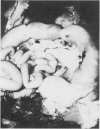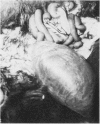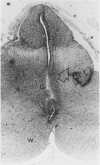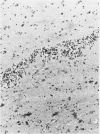Abstract
Breeding experiments were conducted on cats with congenital taillessness, to test the dissemination pattern of taillessness in their offspring. Clinical evaluation, radiographic analysis of the vertebral column and histological studies of the digestive tract and central nervous tissue were conducted to determine the association of malformations of these systems in cats born with different degrees of taillessness noted in the rumpy and stumpy cats.
The mode of transmission of the tailless (Manx) condition assumed to be through an autosomal dominant factor (M) was confirmed by this investigation.
It is hypothesized that the problems associated with the tailless condition such as spina bifida, urinary and faecal incontinence and locomotor disturbances of the pelvic limbs may all be related to a disturbance affecting the development of the central nervous system in the early embryonic life.
Full text
PDF










Images in this article
Selected References
These references are in PubMed. This may not be the complete list of references from this article.
- HOWELL J. M., SIEGEL P. B. PHENOTYPIC VARIABLILTY OF TAILLESSNESS IN MANX CATS. J Hered. 1963 Jul-Aug;54:167–169. doi: 10.1093/jhered/54.4.167. [DOI] [PubMed] [Google Scholar]
- James C. C., Lassman L. P., Tomlinson B. E. Congenital anomalies of the lower spine and spinal cord in Manx cats. J Pathol. 1969 Feb;97(2):269–276. doi: 10.1002/path.1710970212. [DOI] [PubMed] [Google Scholar]
- Kitchen H., Murray R. E., Cockrell B. Y. Animal model for human disease. Spina bifida, sacral dysgenesis and myelocele. Animal model: Manx cats. Am J Pathol. 1972 Jul;68(1):203–206. [PMC free article] [PubMed] [Google Scholar]
- LEMIRE R. J., SHEPARD T. H., ALVORD E. C., Jr CAUDAL MYELOSCHISIS (LUMBO-SACRAL SPINA BIFIDA CYSTICA) IN A FIVE MILLIMETER (HORIZON XIV) HUMAN EMBRYO. Anat Rec. 1965 May;152:9–16. doi: 10.1002/ar.1091520103. [DOI] [PubMed] [Google Scholar]
- Leipold H. W., Huston K., Blauch B., Guffy M. M. Congenital defects on the caudal vertebral column and spinal cord in Manx cats. J Am Vet Med Assoc. 1974 Mar 1;164(5):520–523. [PubMed] [Google Scholar]
- Martin A. H. A congenital defect in the spinal cord of the Manx cat. Vet Pathol. 1971;8(3):232–238. doi: 10.1177/030098587100800305. [DOI] [PubMed] [Google Scholar]
- O'Hare M. J. Aspects of spinal cord induction of chondrogenesis in chick embryo somites. J Embryol Exp Morphol. 1972 Feb;27(1):235–243. [PubMed] [Google Scholar]
- PATTEN B. M. Varying developmental mechanisms in teratology. Pediatrics. 1957 Apr;19(4 Pt 2):734–748. [PubMed] [Google Scholar]
- TODD N. B. THE MANX FACTOR IN DOMESTIC CATS. A POSSIBLE GENETIC BASIS FOR EXPRESSIVITY OF TAILLESSNESS AND OTHER ASSOCATED ANOMALIES. J Hered. 1964 Sep-Oct;55:225–230. [PubMed] [Google Scholar]
- WATTERSON R. L., FOWLER I., FOWLER B. J. The role of the neural tube and notochord in development of the axial skeleton of the chick. Am J Anat. 1954 Nov;95(3):337–399. doi: 10.1002/aja.1000950302. [DOI] [PubMed] [Google Scholar]










